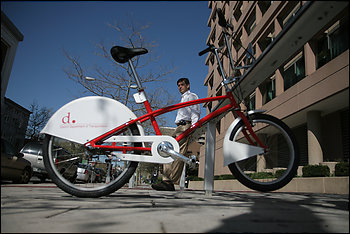
Looks like Washington D.C. will be taking the honors as the first stateside city to launch a real bicycle sharing program. After a pilot program in NYC last summer, I was hoping that my hometown would take the lead. Its hard not to get excited about these sleek looking racks and wheels though, very European.
This weekend The Washington Post marvelously captured the general public’s paranoia about new street furniture, bicycling, sharing, socialist enterprises, and new things in general, when they wrote of the new bike racks:
“Yet another homeland security device?
Actually, they are being installed to make us more like people abroad rather than protect us from them.”
Remain calm.
image: via The Washington Post
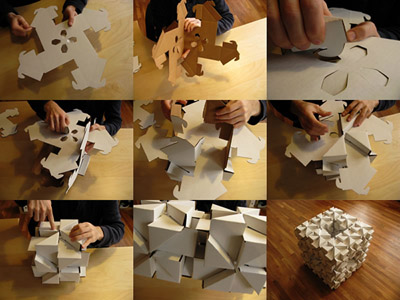
The world should have known that the spawn of Jef Raskin, the “father” of the Macintosh computer, would one day revolutionize a genre of his own – office furniture. Enter the Bloxe, interlocking pieces of cardboard that click together like a life-size lego set to form walls, benches and tables. Aside from its green credentials (far superior to the toxic particle board that most office furniture is made of), the air spaces within the Bloxes help to dampen sound, so you won’t ever have to hear your cubicle mate fighting with her fiancee again! Plus the assemble process looks like a bit of fun if you are mechanically inclined.
Via: Green Tech Blog
FEMA claims that the temporary trailers provided to Hurricane Katrina victims cost only $14,000. Independent investigations by the GAO show that the real cost is more like $229,000 when you factor in transportation, on-site construction and maintenance. To this already staggering number we can now add another hidden cost – health problems caused by formaldehyde off-gassing of the trailer materials. A new congressional report points the finger at FEMA for downplaying reports of formaldehyde exposure. FEMA claims that their tests concluded that air quality inside the trailers was safe “as long as things were properly ventilated.”
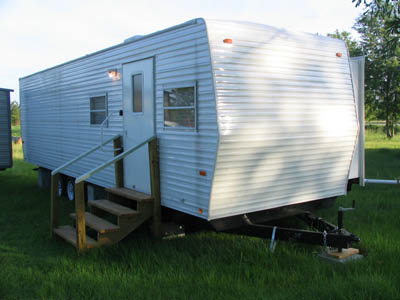
Maybe a better architect, or a FEMA architect, could tell me exactly how you are supposed to ventilate an outsized tin can with four tiny window openings inside four tiny rooms in a humid climate like Louisiana. Sustainably-designed buildings often undergo a “flush-out” period of several weeks to optimize air quality. They are also designed to ventilate naturally, and feature nifty things like fully operable windows, on two adjacent walls even! And porches for shade. A lot of people think that green building is a luxury that only the rich can afford, or that disaster housing cannot be decent housing. A quick review of Rural Studio’s work on the “20K house,” and Shigeru Ban’s cardboard-tube disaster housing illustrates that this is patently untrue. In times of need, architecture can become a redemptive, and sometimes even inspirational force.
Via: The Daily Green and MSNBC
 Have you ever noticed an out-sized evergreen tree in your neighborhood that appears to be sprouting antennae? I think we all know that most evergreens don’t grow to be 131 feet – the height necessary to transmit a cell phone signal. Fake evergreens like this one are literal lightening rods for aesthetic and environmental criticism. Ericsson, along with designer Thomas Sandell, have designed a lean, green answer to these great pretenders – The Tower Tube.
Have you ever noticed an out-sized evergreen tree in your neighborhood that appears to be sprouting antennae? I think we all know that most evergreens don’t grow to be 131 feet – the height necessary to transmit a cell phone signal. Fake evergreens like this one are literal lightening rods for aesthetic and environmental criticism. Ericsson, along with designer Thomas Sandell, have designed a lean, green answer to these great pretenders – The Tower Tube.
Modular concrete construction is used (instead of conventional lattice or tubular steel construction) reducing environmental impact by 40 percent due to material, transportation and energy efficiencies. Natural air convection creates a chimney effect, cooling the interior. All equipment is housed within the slender 16 foot wide structure, eliminating the need for a equipment shed at the base, or an unsightly security fence. It looks like it is time for the cell phone tower to come out of hiding.
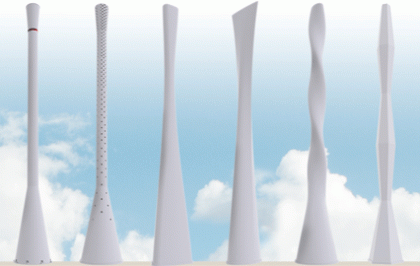
Via: Metropolis Magazine and Ericsson
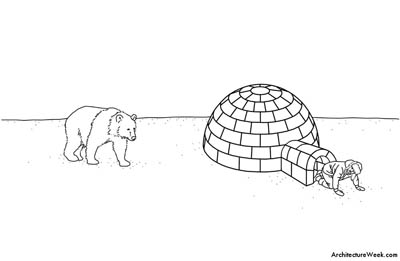
Baby its cold outside, and in case you were wondering how to build an igloo, your friends at Architectureweek have you covered. With a pole, saw, shovel and a little luck, the step by step instructions will have you warm and toasty in no time, and you will even learn some basic principles of physics and sustainable construction in the process. However unless you are in Alaska, Canada or a more exotic locale in the high northern latitudes, you may be out of luck. Suitable dense-packed, dry snow has yet to make its seasonal appearance in my hometown of New York City.
Via: Architectureweek, image by Amelia Bauer
Art loves Miami. Art loves Music. Art loves design. But mostly Art loves New York. There were a great number of these endearing tag lines meant to categorize a plethora of events in and around the Art Basel fair this year. The one thing that everyone seemed to have in common though, was New York. “Where are you from?” meant what borough. When you see your New York City neighbors under the umbrella nearby, you get the funny feeling that you are being followed.
Can you really blame them? If I told you that Art Basel Miami was just like a fun weekend in New York City, but with more art and less clothes, wouldn’t you want to go? There is so much partying going on that the seriousness of the enterprise tends to get overlooked. Which is why it was refreshing to see a few brave designers convey a shred or two of meaning.
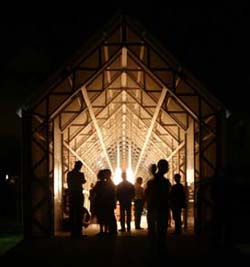 One of my favorite works, unsurprisingly, was an architectural one. Shigeru Ban, best know for his cardboard tube architecture and laudable disaster relief housing, designed an elegant pavilion for Artek. Constructed entirely from recycled plastic beams, it was one of the few things at the fair with a sustainable agenda.
One of my favorite works, unsurprisingly, was an architectural one. Shigeru Ban, best know for his cardboard tube architecture and laudable disaster relief housing, designed an elegant pavilion for Artek. Constructed entirely from recycled plastic beams, it was one of the few things at the fair with a sustainable agenda.
As Art Basel is mostly about looking, check out my slideshow for more images (and commentary.)

Thousands of curiousity seekers, including this one, braved a chilly December day to view a handful of paintings and prints by the mysterious artist Banksy in a claustrophobic townhouse cum gallery in Chelsea. Known for his elaborate street art, known for sneaking his paintings into museums, known for not being known – he is not particularly known for gallery shows, and it was pretty obvious why. His work, like that of most graffiti artists, dies inside a gallery, where it is separated from the street, from buildings, from its context. Graffiti is most interesting to me, because it is the only form of art entirely dependent on architecture as a medium.
There were two compelling ideas presented here that were giggly spoofs on art and commerce. Next to each work was a fairly astronomical price (at least I believe so) scrawled directly on the wall, in pencil. Kind of like a discount store. My favorite piece was a handwritten note, which described a “promotion” of sorts. If you purchased a Banksy piece, an identical work would be installed in a public place by the artist. Now that is giving back!
 This week, July 7-11, steal a New York City bicycle, if only for a 30 minute free ride. The Storefront for Art and Architecture invites you to re-imagine your city with public bikes for the taking on sidewalk corners. Why not? bike-share programs already exist in many cities in Europe – Barcelona, Stockholm, Olso and Vienna to name a few. If you want to learn more, an exhibit of eight successful bike-share programs is on view at Storefront – 97 Kenmare Street. Get inspired by public presentations of European bike-share program organizers.
This week, July 7-11, steal a New York City bicycle, if only for a 30 minute free ride. The Storefront for Art and Architecture invites you to re-imagine your city with public bikes for the taking on sidewalk corners. Why not? bike-share programs already exist in many cities in Europe – Barcelona, Stockholm, Olso and Vienna to name a few. If you want to learn more, an exhibit of eight successful bike-share programs is on view at Storefront – 97 Kenmare Street. Get inspired by public presentations of European bike-share program organizers.
Looking for a place to lock up your bike while you do a little shopping perhaps? You may experience the same problem I had when I rode up to the Union Square Greenmarket last Saturday. Bikes were locked to every conceivable piece of street furniture, and not a bike rack in sight. I now know that bike racks need to be requested, through the NYC Department of Transportation website. Only 3,000 have been installed to date, so let our city know where and when you need one (though I think Union Square is obvious!), and it will benefit all.
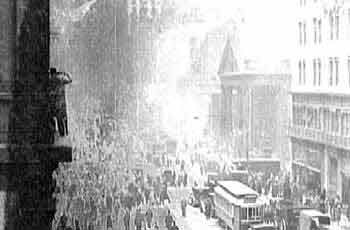
Decasia, an immersive extravaganza created by filmaker Bill Morrison and scored by Michael Gordon, is self-described as a “highbrow rave.” The multi-media event centers around a montage of deteriorating footage from the 1930’s, subject to extensive nitrate degradation, which creates fantastical bubbles, static, fading and otherwordly effects. Through a series of fortiutous circumstances, I found myself on the cold floor of the Angel Orensanz Foundation building, a formerly abondoned synagogue on the lower east side, with the flu, swaddled in my coat and clutching a ginger ale, experiencing this film. It was strangely appropriate environment to be ill in. The synagogue was built for this exact kind of all-consuming performance piece, and the orchestra was set up in the round along the balconies, behind three large screens hung for the projections.
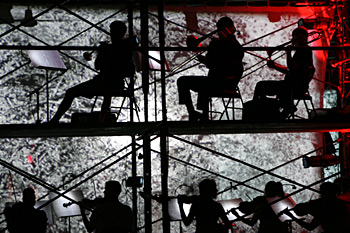
I left with an a renewed curiousity about the materiality of film. Nitrate based film is a curiousity from a materials standpoint – as it is exceptionally hazardous, even deadly. Cellulose nitrate was used as a film base from the birth of cinema in the 1880’s through 1951, when Kodak, the major producer of commercial films, began manufacturing acetate exclusively. Nitrate is both extremely flammable and sensitive to decomposition, which makes it wonderful for artistic purposes, like the Decasia film, but a nightmare from a preservation standpoint. Nitrate decay generates a flammable gas, and projection fires (think of the memorable scene in Cinema Paradiso) were a common and tragic occurance. One byproduct of a Nitrate fire is oxygen – so the fire fuels itself. Nitrate film collections are now classified as hazardous materials, stored in partitioned fireproof rooms. The few theaters in the country which show them must pass rigorous safety tests, including encasing the film completely and extensively fireproofing booths.
For more information on Decasia: http://channel.creative-capital.org/project_270.html
Photos: http://www.ridgetheater.org
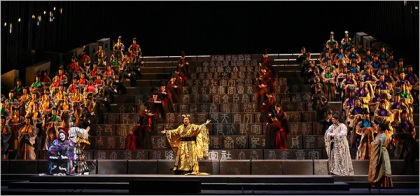
Tan Dun’s The First Empeoror, regardless of whether or not it is the proported second coming of opera, is an architectural spectacle of the highest order. At the center of the restrained set design is a monumental stair of massive blocks, which serve as floor, wall and ceiling, sometimes simultaneously.